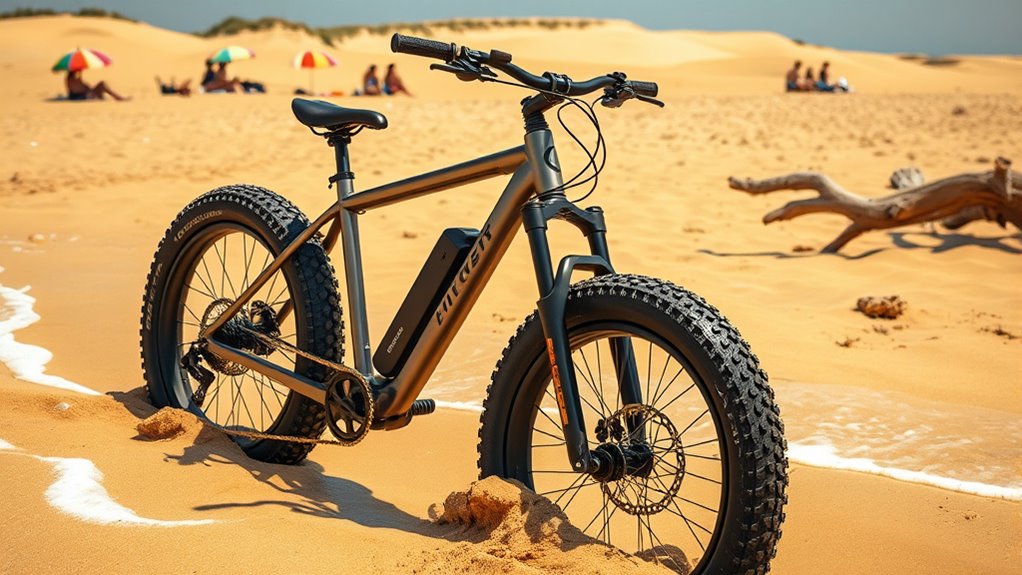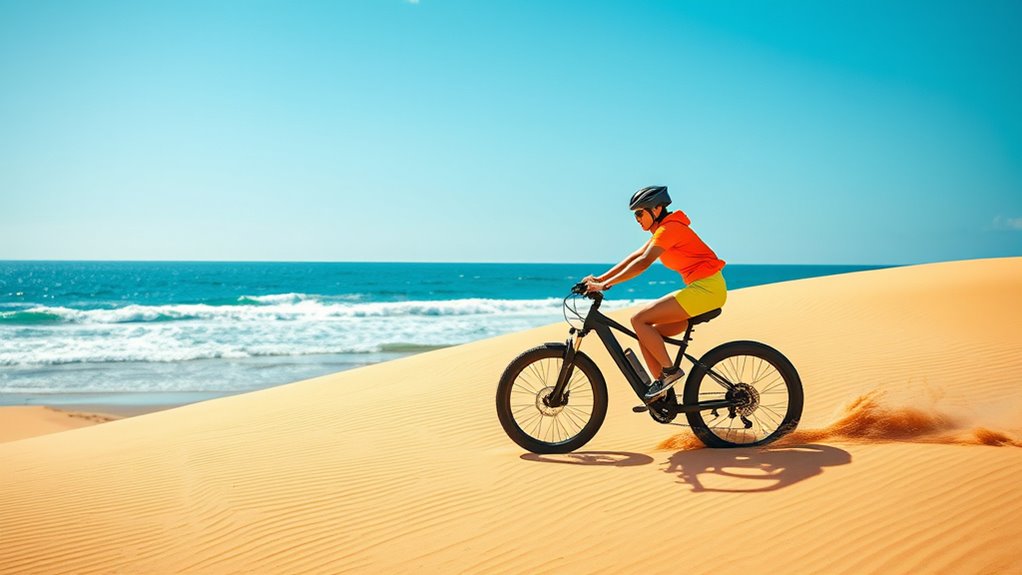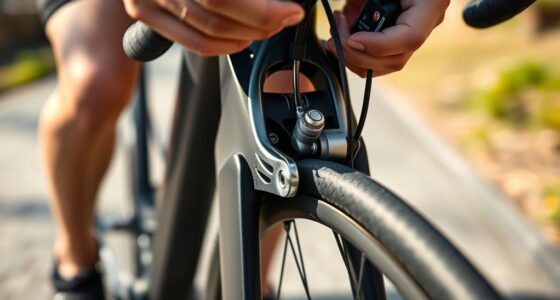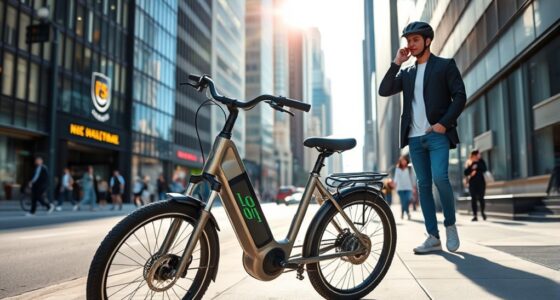Yes, you can ride your e-bike on sand, but you’ll need to prepare properly. Lower your tire pressure to 15-20 psi to improve grip and prevent sinking. Use smooth, steady pedaling and stay relaxed to maintain control. Keep your weight slightly back and look for firm patches of sand for safer riding. Adjust your riding techniques based on sand softness, and consider tire modifications for better traction. For more tips on conquering beach sand, keep exploring ways to ride confidently.
Key Takeaways
- Yes, e-bikes can be ridden on sand with proper tire pressure adjustments and suitable riding techniques.
- Lower tire pressure (15-20 psi) improves traction and reduces sinking on sandy beaches.
- Maintain a steady, moderate speed and keep weight centered or slightly back to prevent front wheel digging.
- Use relaxed body posture, absorb shocks, and avoid sharp turns to navigate soft or changing terrain safely.
- Practice patience, stay alert for soft spots or obstacles, and adapt your approach to different sand conditions for optimal control.

Riding an e-bike on sand can be both exhilarating and challenging, but with the right techniques and equipment, you can navigate sandy terrains smoothly. One of the most important factors to take into account is tire pressure. Lowering your tire pressure increases the contact patch of your tires, giving you better grip and preventing your wheels from sinking into the sand. Before hitting the beach, reduce your tire pressure to around 15-20 psi, depending on the tire size and sand conditions. Be cautious not to go too low, as overly soft tires can risk pinch flats or make steering less responsive. Adjust your pressure based on how soft or firm the sand feels; firmer sand might require slightly higher pressure, while loose, powdery sand benefits from softer tires.
Lower your e-bike tire pressure to 15-20 psi for better grip and stability on sandy terrains.
In addition to adjusting your tire pressure, mastering riding techniques is essential for sandy terrains. Keep your weight centered and slightly back on the bike to prevent the front wheel from digging into the sand. Maintain a steady, moderate cadence—spinning your pedals smoothly rather than abruptly can help you maintain momentum and avoid wheel spin. When approaching a sandy patch, stay relaxed and avoid sudden movements or sharp turns, which can cause you to lose balance or sink. Instead, look ahead and plan your path, choosing the firmest, most packed areas of sand for better traction. Use your body to absorb shocks and maintain stability, keeping your elbows slightly bent and staying loose on the handlebars.
Momentum is your best friend when riding on sand. Maintain a consistent speed, avoiding sudden acceleration or deceleration that might cause you to lose control. If you start to bog down, don’t panic; ease off the throttle slightly and try to find a more packed section of sand. If you get stuck, resist the urge to pedal harder—this can dig your tires deeper. Instead, try to keep moving by shifting your weight back and, if possible, dismount and walk your bike over particularly loose patches. When riding on beach sand, especially near water or soft dunes, be extra cautious of changing terrain, and always stay alert for soft spots or hidden obstacles. Incorporating a suitable tire setup can significantly improve your traction and riding experience on sand.
Ultimately, patience and practice are key. With a little preparation—adjusting your tire pressure and refining your riding techniques—you’ll find that riding your e-bike on sand becomes less intimidating and more enjoyable. Over time, you’ll develop a feel for how your bike interacts with different sand conditions, allowing you to ride more confidently and explore beaches with greater ease.
Frequently Asked Questions
Are E-Bikes Allowed on All Sandy Beaches Worldwide?
You might wonder if e-bikes are allowed on all sandy beaches worldwide. The answer depends on local regulations, which vary by location. Some beaches permit e-bike riding, enhancing beach accessibility, while others restrict it to protect the environment and ensure safety. Always check local rules before riding your e-bike on a beach. Respect signage and regulations to enjoy your ride responsibly and help preserve these beautiful areas.
How Do Sand Conditions Affect E-Bike Motor Performance?
Think of riding your e-bike on sand like dancing on a shifting floor. When sand is loose or soft, your tire traction drops, making it harder to control your bike. This increased effort can cause your motor to overheat, especially if you push too hard. To avoid this, ride slowly, keep your tires properly inflated, and take breaks to let your motor cool down. This way, your ride stays smooth and safe.
Can I Ride an E-Bike in the Ocean Surf Zone?
You probably wonder if you can ride your e-bike in the ocean surf zone. While it might seem tempting, you should follow beach etiquette and avoid riding in the water to prevent damage. Most e-bikes aren’t water-resistant enough for saltwater, which can harm the motor and electrical components. For safety and preservation, stick to dry, designated paths and respect beach rules to enjoy your ride responsibly.
What Safety Gear Is Recommended for Riding on Sand?
You might worry about safety gear when riding on sand, but don’t skip it—your protection matters. For effective sand riding techniques, wear a helmet, gloves, and knee pads, especially if you fall. Choose e-bike tires suitable for sand to prevent slipping. Wearing reflective clothing and eye protection also helps stay visible and safeguard against debris. This gear boosts your confidence, making your sandy adventures safer and more enjoyable.
How Do I Prevent My E-Bike From Getting Stuck in Sand?
To prevent your e-bike from getting stuck in sand, you should focus on adjusting tire pressure and using the right riding technique. Lower your tire pressure to increase surface area, giving you better traction and reducing the risk of sinking. Keep your weight slightly back and pedal smoothly with steady, controlled power. This approach helps you maintain momentum and stay on top of the sand, making your ride safer and more enjoyable.
Conclusion
Imagine your e-bike as a sturdy boat, gliding smoothly over a sandy sea. With the right precautions and techniques, you can navigate the dunes just like a sailor steering through gentle waves. Respect the shoreline’s delicate balance, and your ride becomes a harmonious dance with nature. So, gear up, stay mindful, and enjoy your adventure—because with the right approach, riding on sand transforms into a graceful voyage across a golden ocean.









